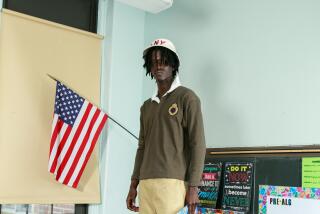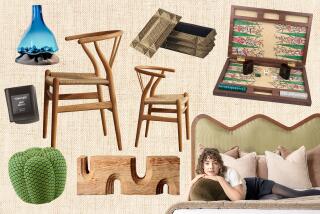Book review: ‘The Design Work of Edward Barber and Jay Osgerby’
Furniture and product designers Edward Barber and Jay Osgerby are the Astaire and Rogers of 21st century minimalism. The objects they make — be it an oak choir bench for the Gothic-style Portsmouth Cathedral in England or plastic clothes hangers for Levi’s jeans — look effortlessly graceful. Derived from origami-style models and geometric forms, their sculptural designs in plywood, unfinished oak, glass, marble and rainbow-colored anodized aluminum are executed with impeccable style and polish.
The British duo created the folded aluminum facades on H&M stores, including the one on Sunset Boulevard in Los Angeles, but because they specialize in pricey limited editions, they are barely known outside design circles. The recent release of a handsome monograph, “The Design Work of Edward Barber and Jay Osgerby” ($75) by Rizzoli, will delight existing fans and win over design enthusiasts who not only love beautiful home furnishing but are also interested in the marriage of computer-generated design with traditional craft.
“Edward and Jay use industry as craft,” designer and educator Bruce Mau writes in the foreword. “They create magical objects that marry the segregated worlds of the handmade with those of industrial technology, graphic language and art.”
Pompous, these 42-year-olds are not.
“We relish the moment when a sketched idea or rough model becomes a conversation between us and the maker, engineer or technician,” write Barber and Osgerby, whose sharing of professional duties includes, it seems, writing. “A design must meet the requirements of the production experts. This rarely happens at the first attempt, but a dialog ensues which is accompanied by a great deal of sketching and coffee.”
When the work seems basic to the point of prompting an I-could’ve-done-that reaction (no, you couldn’t), the authors provide detailed descriptions of how each deceptively simple product was inspired and developed, what materials were used and how they were produced. That may sound dry — and at times they do write in fairly dense artist-speak — but Barber and Osgerby have a sly wit. It’s evident in the names they give their designs: An umbrella stand named Poppins is not only a nod to the Disney nanny but also describes how the umbrellas fit into the stand. Likewise, the Filo sofa is a simple oak frame piled with colored cushions layered like Greek pastry dough.
Barber and Osgerby leave to others the heavy lifting of explaining why their work is important. As befits a career retrospective, the book contains essays by the design curator at the Art Institute of Chicago and the director of the Design Museum in London. It’s a book for looking, not necessarily for reading home decorating tips, but in a discussion about their eye-catching color-wheel-inspired Iris table, Barber reaffirms at least one golden design rule.
“There’s something very invigorating in a mass of color,” he says, “something uplifting in a country garden filled with flowers or a bookshelf packed with rows of different colored spines.”
More to Read
Sign up for our Book Club newsletter
Get the latest news, events and more from the Los Angeles Times Book Club, and help us get L.A. reading and talking.
You may occasionally receive promotional content from the Los Angeles Times.






